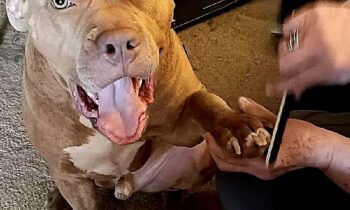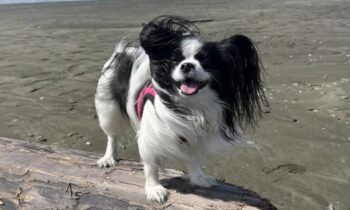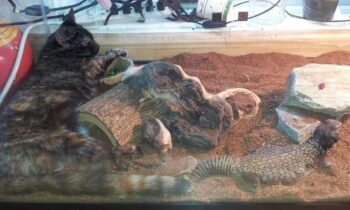
Your puppy is four months old. You’re doing well with housebreaking, crate training, and bite inhibition. She even walks fairly nicely on a leash . . . most of the time! You enrolled your family in a great puppy class and you and your pup have enjoyed it immensely—you all learned so much!
You’re very happy with your new family member.
Your puppy spent some time at another home while you and your family were out of town.
You’re curious about how she reacted and behaved her first time away from home.
This is an example of what someone like me might tell you about your puppy’s first visit:
Food
Your puppy didn’t eat all of her first meal for this visit, but don’t worry—that’s fairly normal. Eating away from home often ends in a half-consumed meal or even a wholly-ignored meal, especially for the first time in a new place or with new people and pets. For some dogs, it can take a couple of days in a new atmosphere to regain an appetite, although puppies usually relax enough to eat within a shorter time, as they’re always hungry.
Your puppy ate every meal after that first one, promptly and completely, and that’s what’s important. She’s got a lot of growing to do before she becomes a dog!
Elimination
Your puppy knows exactly what to do first when she’s let outside—she pees. I did observe that she always pees very close to the back door, at the bottom of the steps. That habit may well have started when she was younger, when she had a smaller bladder and she was rushed to “do her business” immediately outside before she could “leak” inside.
I’d caution that “right outside the back door” is not an ideal place for a dog to eliminate. I suggest that you consider how to encourage her to urinate in a more convenient and acceptable spot farther from where humans enter and exit your home.
(It’s especially important in this part of the country to aim for your puppy to be “doing her business” farther away from your back door because . . . winter. In warm weather, you can easily clean up the mess and remove the smell by hosing down that area regularly, but once the snow and ice is packed by those back steps, how do you remove the yellow spots before spring? Plan ahead—now!)
To encourage your puppy to “go” in a more appropriate place in your own yard, you can walk out with her when you know she has to pee, holding her attention with happy talk, hands clapping, until you get to the spot you’ve chosen for her. Then stop, be quiet, stand still, and wait. Praise and reward in whatever way works best for your puppy once she’s eliminated, then stay and play a while!
Your puppy loves water, at least in sprinkler format, so I’m not too worried about her learning to eliminate outside when it’s raining. However, it wouldn’t be a bad idea to take her out in mild downpours (not thunder and lightning) when you’re able, staying outside and playing with her after she eliminates. Snow and ice will be another challenge, one for which it’s not as easy to practice, but keep in mind she’s much more likely to be comfortable in any weather if you’re with her when she “goes.”

Photo by Amy Suggars
Returning Inside
Your puppy astounded me by coming in from the back yard willingly, every single time, without hesitation. In fact, she was often waiting on or near the back steps when I came out to take her in. That is highly unusual, in my experience, for a puppy of her age—much less for most full-grown dogs.
It’s not as difficult to deal with in summer weather, when you can just go out with a treat or toy (or leash!) to lead the dog inside, but believe me, in winter when it’s icy, it’s no fun (and sometimes even dangerous) to track down a recalcitrant dog who’s doing his best to escape a slippery capture.
Being Handled
I was glad to find out, right after I discovered how much she liked water, that she is also used to and very tolerant of being toweled off after she runs in the sprinkler. Thank goodness! You might invest some time in getting her “used to” the sound of a hair dryer, because there’s a good chance that you or a groomer will use one on her in the future. (If you have a powered toothbrush, get her “used to” that sound as well, a groomer friend recommends. It sounds a lot like the clippers groomers use.)
Your puppy is also good about being handled. She has no objections to having her paws touched, her ears lifted, her eye-corners cleaned, her teeth checked. She stood still without restraint when I brushed her back and sides gently. Your family should keep up the good work you’re doing because grooming will be an important part of this dog’s life. She’ll go to a professional regularly, but your family will be responsible for what needs to be done on a daily and weekly basis, like combing and brushing her fur, cleaning her teeth and her ears, trimming her nails, and keeping her tidy.
A Crate for Sleeping
I was surprised and delighted that your puppy, after a few choruses of “Why am I not out there with you?” quieted quickly in the crate when it was bedtime. She did not make a sound through the whole night, giving the rest of the household a full night’s sleep and the energy to face another day with her!
She cooperated with going into the crate from the first time I asked her to do so, and quickly learned that she would get a good-sized treat (as opposed to the tiny training treats) once she was inside it. She subsequently learned to remain inside it without popping out while I delayed the delivery of the good-sized treat. She also learned to “wait” when I opened the door to the crate a few inches to reach in for her empty bowl . . . instead of bursting out as I unlatched it!
You have obviously done a great job already on crate-training. Keep up the good work!
Navigating the House
She sits at closed room doors but barrels through when the door is only slightly open. That is especially noticeable when she bashes into a big dog and bowls over a small dog in her haste to go first.
You may find something like that is going on with your family, so I’d suggest “wait” at doors until you cue her it’s okay to go through, for everybody’s safety.
I also observed that she seems used to opening unlatched doors by bashing them hard with her front paws. That has got to stop. It probably will if you remember to latch or lock all doors so she can’t be rewarded by bashing through them with her paws.
Feline Friends
Your puppy was lovely with our cat! I know you have a cat at your house and, if I recall our conversation correctly, while your puppy is very interested in your cat, your cat has not fully accepted the puppy’s friendship. Not so at our house! Your puppy and our cat touched noses when they met. The cat was standing atop a medium-sized crate, so she had the height advantage. (Our cat is very smart about dogs.)
Your puppy never attempted to chase the cat and she was always respectful when they encountered each other around the house. Your puppy did not “bounce” at the cat at all!
Refining the Bark
Your puppy barks and, from what I’ve observed, has a good start on being an excellent watchdog and alarm-giver. What she needs now is lots of feedback and direction about what should be barked at and for how long. I think her hearing must be excellent because I’m practically positive she barked back several times at dogs on TV upstairs—in an exact mimic of those TV dogs’ barks!
Think about the sounds of the various barks she makes. Is it for kids playing in the street, someone at the door, your family car in the driveway? Decide how you’d like to respond to each kind. Most important, don’t squelch the barks: teach her how many barks are appropriate and reward her for stopping.
Bite Inhibition
Best of all, I can say about your puppy that I never felt a tooth—not even once during her visit! That’s what happens when you work on bite inhibition while puppy teeth are still attached. Now that her adult teeth are coming in, it’s even more important. Pups must learn never to bite down on human skin or clothing. I am so happy that your puppy has, it seems, learned that lesson well already—especially since your family includes two human children! (It’s a lesson some dogs never learn. So sad!)
A Crate for Traveling
I was also very pleased when I realized you came to pick up your puppy with a crate in your car. That’s something I always mention when I see dogs riding loose in vehicles. It’s important to me that dogs I like very much continue to live, which is why I’m so adamant about secure confinement in cars! I didn’t have to tell you twice. I won’t have to keep saying it for years, the way I do with some people! I know your wonderful puppy will be safe when you transport her, and that’s a very good feeling!
Enjoy your puppy, teach her and let her teach you. You’ve got a good one, that’s for sure!



